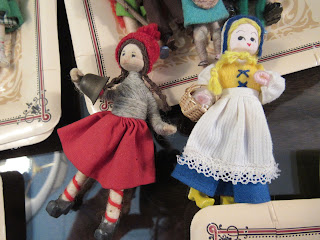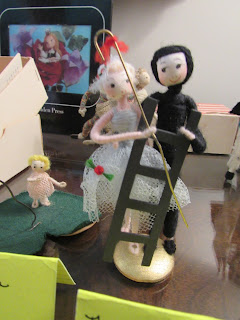Grecon Dolls
Grecon dolls were produced by Margarete Cohn, a
Jewish refugee who fled Germany and went to London in 1936. Ms. Chon Attended Arts and
Crafts School in Germany after WWI. By 1919 she had obtained a patent for a
head and was producing dolls. Ms. Cohn quickly shifted from making bisque to the
cheaper cloth dolls. The trademark was Grecon
which is a contraction of her name "Grete and Cohn = Grecon". Ms. Cohn trained others to
produce dolls in London, creating a cottage industry. Faced with restrictions on raw materials, Ms. Cohn
used scraps to create her small scale, wool wrapped, wire armature dolls. Ms. Cohn was successfully able to produce dolls
during the Battle of Britain. After WWII, Ms. Cohn wanted
to expand the business and markets. In
1946 she showed her dolls at an exhibit at the Victoria and Albert Museum and worked to expand British products overseas.
Ms Cohn was successful, for Grecon dolls could be found in the US at Dept
Stores like Pittsburgh’s Hornes and through catalog companies. In 1952 A. Barton and
Co, a London doll house and miniature manufacturer became distributor for
Grecon dolls, which lasted until 1960s. Harrod’s, Hamley’s, and
small shops in London carried the dolls as well.
Ms. Cohn made basic
doll house family (mom, dad, older brother and sister, and a baby and sometimes
younger kids). Grandparents fascinated
her - she also made a bridal party, cowboy/girl,
nursemaid, maid, chef, chauffeur, police, postman, pianist, etc. The dolls were either
1:21 scale or 1:18 scale. Those are the two known scale sizes. Great attention was
paid to detail of clothing and yarn ties, miniscule buttons, lace collars,
purses, yarn jewelry, net stockings, embroidered flowers, loop and eyelet
eyeglasses, and tiny bead earrings were used. The doll's faces were padded net
with handpainted features – some dolls had yarn ears. Hair was embroidered onto the doll's heads. The doll's clothing was made of felt, cotton, jersey, and wools. Grandparents- were a
favorite subject of Grete’s and almost always wore glasses. Grandfather dolls wore hounds tooth
trousers, gray vest, and black morning jacket. “Bobby” dolls were
souvenirs for London gift shops. The dolls were marked with tags (rectangular
cloth tags) sewn onto back of clothing. The tags usually said “Grecon Little People”
or “Grecon Made in England”. Paper tags and foil
tags were sewn onto back of clothes as well – esp. on larger dolls (Grecon –
made in England – London)
Alice Jorgensen Dolls
Ms. Jorgensen made similar dolls to Grecon. The dolls were made of thread and yarn wrapped around wire frames and had a paper label attached to the base "A. Jorgensen". Examples of Ms. Jorgensen's dolls are below
Anne Beate
Anne Beate originally worked with alice Jorgensen. In the 1960's, Ms. Beate began making pixies. The first pixies were a boy carrying sack and girl holding bell are older. The dolls had brown and yellow yarn hair. The implements the dolls carried help to date Ms. Beate's dolls. The adults were 4" tall. The children dolls were 3.375" tall. The dolls had foil tags.














